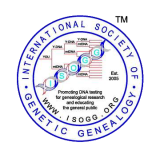Mitochondrial DNA
From ISOGG Wiki
Mitochondria are small organelles that lie in the cytoplasm of eukaryotic cells, such as those of humans. Their primary purpose is to provide energy to the cell. Mitochondria are thought to be the vestigial remains of symbiotic bacteria that were once free living. One indication that mitochondria were once free living is that they contain a relatively small circular segment of DNA, called mitochondrial DNA (mtDNA). The overwhelming majority of a human's DNA is contained in chromosomes in the nucleus of the cell, but mtDNA is an exception. Individuals inherit their cytoplasm and the organelles it contains exclusively from their mothers, as these are derived from the ovum (egg cell) only, not from the sperm. Males inherit mtDNA from their mothers but do not pass it on to their children. Consequently when a mutation arises in the mtDNA molecule, the mutation is passed on in a direct female line of descent. These rare mutations are derived from copying mistakes – when the DNA is copied it is possible that a single mistake occurs in the DNA sequence, an outcome which is called a single-nucleotide polymorphism (SNP).
Contents
Further reading
- Far from special: Humanity's tiny DNA differences are 'average' in animal kingdom. Eureka Alert, 21 May 2018.
- How energy shapes life: our mitochondrial partners by Claire L Asher, UCL Genetics, Evolution and Environment blog, 21 June 2013
- What is mitochondrial DNA? from the Genetics Home Reference Handbook
- What is mitochondrial DNA? from the Genetics Home Reference Guide to Understanding Genetic Conditions
- Mitochondria An explanation from Nancy Custer
- Mitochondrial DNA An article from the US National Forensic Science Technology Center
- What is mitochondrial DNA and mitochondrial inheritance? SME Science, 10 April 2017.
- Wikipedia article on mitochondrion
See also
Resources
- Ian Logan's mtDNA website
- Mitomap A compendium of polymorphisms and mutations of the human mitochondrial DNA
Licence
This article is licensed under the GNU Free Documentation Licence. It uses material from the Wikipedia article "Genetic genealogy".

